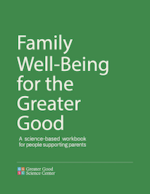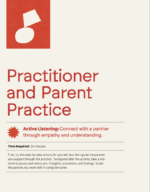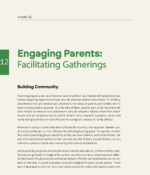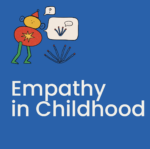Module Introduction
Empathy in Context
Empathy—the ability to perceive and try to understand another person’s emotions and thoughts—is a key to personal well-being, a necessary ingredient for thriving relationships, and a glue that helps hold society together. Unfortunately, evidence suggests Americans are becoming less empathic over time, possibly due to modern life elements that aren’t conducive to fostering empathy. “[T]hese days, the rules that encourage empathy are being broken,” says empathy researcher Jamil Zaki.
Humans evolved to experience empathy as a means of survival. Our Paleolithic ancestors lived in small groups of people they knew well and counted on—a situation ripe for empathy, explains Zaki. We, however, live in a very different world and are more socially isolated. We often interact with others online, and we cannot see their facial expressions. When we hear about people suffering worldwide, we see them impersonally as statistics. This context makes empathy more difficult. Fortunately, hundreds of studies demonstrate ways to foster a greater sense of empathy if we try.
Listen to Jamil Zaki speak about empathy below.
Individual Exploration
What is Empathy?
The term “empathy” describes a wide range of experiences. Emotion researchers generally define empathy as the ability to sense other people’s emotions and imagine what someone else might be thinking or feeling. Contemporary researchers often differentiate between two types of empathy:
- “Affective empathy” refers to the sensations and feelings we get in response to others’ emotions; this can include mirroring what that person is feeling or feeling stressed when we detect another’s fear or anxiety.
- “Cognitive empathy,” sometimes called “perspective-taking,” refers to our ability to identify and understand other people’s emotions.
Empathy seems to have deep roots in our brains, bodies, and in our evolutionary history. Our primate relatives, dogs, and even rats exhibit elementary forms of empathy. Some researchers hypothesize that empathy evolved as a parental instinct in mammals because it motivates parents to care for their vulnerable offspring. Scientists have associated it with two different pathways in the brain, and they speculate that some aspects of empathy can be traced to mirror neurons. These neurons fire in our brains when we observe someone else act, much like they would if we performed that action ourselves.
Empathy is fundamental for nurturing social connections. Empathic people make friends more easily. Being able to understand your romantic partner’s emotions deepens intimacy and boosts relationship satisfaction, and it’s fundamental to resolving interpersonal conflicts. Empathy is thought by many to be the baseline of morality. Empathy doesn’t necessarily drive people to want to help someone in need, but possessing it is frequently a vital first step toward compassionate action. Some studies have found that people with higher levels of empathy are more likely to help others, even when doing so goes against their self-interest. While people have an easier time empathizing with people they consider to be more like them, practicing perspective-taking reduces prejudice and racism.
Empathy in Childhood
Humans experience affective empathy from infancy. Babies physically sense their caregivers’ emotions and often mirror those emotions. Babies can distinguish between happy and fearful faces; their brains respond differently to different vocal emotions; and they will cry when other infants cry.
Cognitive empathy emerges later in development, around three to four years of age, roughly when children develop an elementary “theory of mind”—that is, the understanding that other people experience the world differently than they do. Children continue to develop their empathic abilities throughout childhood and adolescence.
Many elements can impact a child’s sense of empathy. Children with autism may have an easier time with affective empathy than cognitive empathy. Children in lower socioeconomic classes are more accurate in judging the emotions of other people than people with higher socioeconomic status. Children with a parent with an auditory or visual disability have higher levels of empathy and emotional literacy than children of parents who do not have these disabilities. Children from multiethnic and/or multi-faith families may have stronger empathy and conflict-resolution skills.
Evidence suggests that teaching children empathy skills helps them socially and morally. Studies of Mary Gordon’s innovative Roots of Empathy program, which brings babies into classrooms to teach empathy and emotional literacy, have found that it decreases bullying and aggression among kids and makes them kinder and more inclusive toward their peers. Watch Mary Gordon speak about the Roots of Empathy program below.
Empathy in Parenthood
“Empathy is vital for being able to respond sensitively to our children’s distress,” write Jessica Borelli and Stacey Doan, researchers and authors of Nature Meets Nurture: Science-Based Strategies for Raising Resilient Kids. Empathy helps parents understand their child’s perspective and anticipate their needs, yet it has other benefits. In one study, adolescents with more empathic parents were better able to regulate their emotions, and the more empathic parents themselves had greater self-esteem and life purpose than parents with less empathy.
While parenting changes the brain to help moms and dads become more empathic, that doesn’t mean parenting is always easy. “Parents sometimes struggle to express empathy when they do not like the way the child is expressing their feelings, like when children behave aggressively when they are angry,” write Borelli and Doan. Parents with depression may especially struggle to empathize with their children. Highly empathic parents may struggle with the “empathy trap”—empathizing so much with their children that they have difficulty separating their child’s feelings from their own. This can lead parents to try to “fix the feeling” rather than teach their children that negative emotions are a tolerable part of life.
Another situation where empathy can be challenging is parenting after a separation or divorce, particularly when parents are struggling with poverty, a lack of affordable housing, and other stressors. Family Paths, a non-profit organization that offers a parenting support program for solo dads in Alameda County, California, found that practicing taking the perspective of their children’s moms by roleplaying helped dads learn to empathize with their co-parent, de-escalated feelings of rage, and helped them communicate more mindfully.
Nurturing Empathy
Researchers have identified several ways to nurture empathy in both children and adults:
- Believe that empathy can be learned: People who think their empathy levels are changeable put more effort into being empathic, listening to others, and helping, even when it’s challenging.
- Get out of your own head: Research shows that actively imagining what someone else might be experiencing can increase levels of empathy.
- Don’t jump to conclusions about others: We feel less empathy when we assume that people suffering are somehow getting what they deserve.
- Be mindful: Practicing mindfulness helps us take other people’s perspectives yet not feel overwhelmed when we encounter their negative emotions.
- Meditate: Meditation—specifically loving-kindness meditation, which focuses attention on concern for others—might increase the capacity for empathy.
- Explore imaginary worlds: People who read fiction are more attuned to others’ emotions and intentions.
- Pursue diverse friendships: Getting to know people who are different from us makes it easier for us to empathize with them and reduces prejudice towards others of that group, as a study of Catholic and Protestant schoolchildren in Northern Ireland found.
- Join the band: Playing music together boosts empathy in kids.
- Play games: When we compete against others, our brains are making a “mental model” of the other person’s thoughts and intentions.
Empathy Self-Reflection
Fostering a sense of empathy is vital for our relationships. Take a moment to reflect on your experience with empathy before you bring the information from this chapter to the parents you work with.
- Read the list of statements below and ask yourself these questions:
- How much do you agree or disagree with each of the statements?
- What do these statements make you aware of about your sense of empathy?
- Do your responses reveal opportunities for growing your empathy toward others?
- I easily feel sad when the people around me feel sad.
- Before criticizing somebody, I try to imagine how I would feel if I were in their place.
- I find that I am “in tune” with other people’s moods.
- I try to look at everybody’s side of a disagreement before I make a decision.
- I sometimes try to understand my friends better by imagining how things look from their perspective.
- Reread the statements as you seek to understand the role of empathy in the lives of the parents you support professionally.
- How much do you think the parents you work with agree or disagree with each statement?
- What strengths are in the community that support empathy towards others?
- What could the community provide to help parents experience and express more empathy?
- What experiences or challenges with empathy have parents shared with you that could guide other parents looking for ways to empathize with their children and others?
Practices to Foster Empathy
Now that you have been introduced to this topic, you can explore practices to nurture empathy. The first is a “Practitioner and Parent Practice.” Use it to nurture your well-being. Next, share the same practice with parents to guide them in fostering their well-being. The second is “Parent-Child Practices,” which you can share with parents. They are empathy activities for parents and children.
Practitioner and Parent Practices
First, try this step-by-step activity for yourself and then guide the parents you support through the practice. During and after the activity, take a moment to pause and notice your thoughts, sensations, and feelings. Guide the parents you work with in doing the same.
Active Listening: Connect with a partner through empathy and understanding.
Parent-Child Practices
You can guide parents on these step-by-step activities to support empathy. During and after the parenting activity, encourage the parents to pause to notice their thoughts, sensations, and feelings.
Listening to Teens With Love: Create a warm, non-judgmental space for teens to talk.
Discoveries, Wonderings, and Commitments
- Discoveries
- What three to five crucial takeaways about empathy are most relevant for you personally and professionally?
- How much of a challenge is fostering empathy in your community?
- Wonderings
- How might parents in your community respond to the empathy practices?
- What kinds of modifications to the empathy practices would you consider making to meet the specific needs of the parents in your community?
- Commitments
- What actions do you intend to take based on your learning about empathy for yourself? For the parents you work with?
- Which empathy practice will you share with the parents you work with? What will you say and do to guide them in trying this practice?
Additional Empathy Resources
- Video: How to Keep Your Empathy Switched On
- Article: Six Ways to Respond to Your Kids’ Big Feelings
- Article: How to Avoid the Empathy Trap
- Article: In a Divided World, We Need to Choose Empathy
Module Resources
This workbook offers parenting practitioners practical lessons and activities to help the reader prioritize cultivating your social and emotional well-being while additionally supporting you in sharing these insights and practices with the parents and families you serve. This workbook includes a chapter on empathy as well as chapters on foundational topics like cultural humility, coparenting, healing and resilience and more.
This is an exercise to help you connect with a partner through empathy and understanding.
Group Facilitation
Before facilitating parent groups, spend time in individual exploration in order to experience and embody the learning. In this tab, you will find:
- A chapter with resources for engaging parents and facilitating parent gatherings. (Chapter from GGSC’s Family Well-Being for the Greater Good: A science based workbook for people who support parents)
- A turnkey revisable slide deck designed to support you in facilitating a parent gathering about cultivating empathy.
- A printable handout for parents to take home that includes information about the importance of empathy for parents and children as well as activities to empathy.
Module Resources
This chapter provides support for planning and facilitating parent gatherings. It includes information on building community, reducing barriers to participation, creating welcoming environments, group agreements, and more.
This slide deck is a tool that you can edit and use to share resources on cultivating empathy at an upcoming parent night. If you prefer working in Google Slides, you can download a copy of this Google Slide deck to edit: https://bit.ly/3AMxwEQ
This handout can be printed and shared with parents. In addition to introducing parents to the benefits of cultivating empathy, this handout includes links to resources on cultivating empathy for parents and for children.

Do you want to dive deeper into the science behind our GGIE practices? Enroll in one of our online courses for educators!








Comments